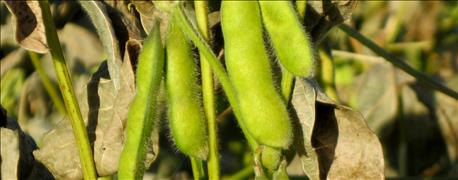June 17, 2016

It’s almost prime time for soybean pests, diseases and nutrient deficiencies. Here are the top six to watch out for in South Dakota and North Dakota, according to Jim Ruhland, DuPont-Pioneer agronomist, Mitchell, S.D.

COMING ON: Soybeans are entering the midseason phase, when pests will threaten yield potential.
Soybean aphids can take a big bite out of yields. In untreated heavy infestations, they can reduce yields by more than 10 bushels per acre. Feeding by soybean aphids causes flowers and small pods to abort, reducing the number of pods per plant. Aphid feeding also robs the soybean plant of nutrients, reducing the number of soybeans per pod and soybean size. Aphid-infested plants will appear shorter than uninfected plants and may also look similar to plants experiencing potassium deficiency: having yellowed, curled leaves.
Tip: Conduct aphid counts on 30 to 50 plants throughout an entire field to calculate the average number per plant. If aphid populations reach 250 per plant and are increasing during the R1 to R5 growth stages, consider a foliar insecticide application to control populations.
Soybean cyst nematode (SCN) can cause stunting and yellowing symptoms similar to those of certain nutrient deficiencies. Inspect the roots of affected plants for the presence of cysts, or analyze for the presence of SCN.
Tip: Planting SCN-resistant varieties and rotating non-host crops are the best methods for control. SCN host crops include soybeans and other beans, clover, peas and vetch. Rotating to crops like corn, alfalfa, barley, canola, oats, rye or others can help reduce populations.
Soybean sudden death syndrome (SDS) can cause large yield losses when infections are severe. Symptoms typically appear in July and August, even though the infection begins much earlier. SDS can be identified by leaf symptoms, which begin with scattered, diffused yellow spots between the veins. The spots expand into brown lesions surrounded by chlorotic areas.
Tip: Varietal resistance combined with soybean cyst resistance is the main method of management.
Brown stem rot (BSR) is more severe when conditions are good for soybean growth, and it can cause up to 40% yield loss. Foliar symptoms are similar to those of SDS, but after BSR infection, internal stem tissue turns brown. Symptoms are worsened if an infection is followed by drought stress during pod fill.
Tip: Manage BSR by rotating out of soybeans for multiple years at a time, using tillage that encourages residue composition and planting soybean varieties that have good resistance to SDS and SCN.
White mold lives in soybean fields on sclerotia. Sclerotia are ¼-inch to ½-inch long and are formed within the white, cottony growth both inside and outside the stem. Wet, cool conditions are ideal for white mold development, prompting germination of sclerotia in the soil, spore release and spread of white mold from plant to plant. Shaded canopies in narrow-row production and early planting can also promote disease development. Prevent disease spread with fungicide applications:
Tip: Sequential applications at the R1 and R3 stages have proven more effective than a single application.
Nutrient deficiencies can also cause yield loss. Iron deficiency is the most commonly observed nutrient deficiency in soybeans; reduce its chance of developing by selecting a soybean variety with a strong tolerance to iron deficiency chlorosis. Potassium deficiency can be managed through soil testing and application. Manganese deficiency is rare but can occur in high-pH and sandy soils; in the case of chlorosis, apply manganese as needed.
“The best defense against pests, diseases and nutrient deficiencies is regular monitoring and early intervention when appropriate,” Ruhland says.
Source: DuPont-Pioneer
You May Also Like




